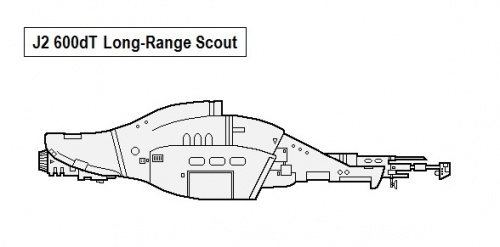Ulysses class Long-Range Scout
| Ulysses class Long-Range Scout | |
|---|---|
 Distant Fringe vessel | |
| Type: SL Exploration Vessel | |
| Category | ACS |
| Size | 600 Tons |
| Hull Configuration | Cone Hull |
| Streamlining | Streamlined Hull |
| Tech Level | TL–11 |
| Engineering | |
| Computer | Model/3 |
| Jump | J-2 |
| Maneuver | 3 G |
| Armaments | |
| Hardpoints | 6 |
| Accommodations | |
| Staterooms | 20 |
| Low Berths | 20 |
| Personnel | |
| Crew | 20 |
| High/Mid Passengers | 0 |
| Low Passengers | 20 |
| Payload | |
| Cargo | 25 Tons |
| Fuel tank | 267 Tons |
| Construction | |
| Origin | Distant Fringe |
| Price | |
| Cost | MCr413.848 |
| Statistics | |
| Quick Ship Profile | SL-FS32 |
| Universal Ship Profile | SL–6223332–050000–40003-0 |
| Images | |
| Blueprint | No |
| Illustration | Yes |
| Source | |
| Canon | Unpublished, fan design |
| Designer | Ade Stewart |
| Design System | High Guard |
| Era | 1105 |
| Reference | Fan: Ade Stewart] |
The Ulysses class Long-Range Scout is a TL–11 science research starship.
- Please also see AAB article: Ships of the Distant Fringe.
Description
It is a vessel with 3-G and J-2 performance. The Ulysses class is a survey vessel occasionally encountered within the Distant Fringe region. It is classified as a Research Ship and is constructed as a long-range design. Similar designs have been in use from the time the Distant Fringe was first settled.
Image Repository
Basic Ship Characteristics
Following the Imperial Navy and IISS Universal Ship Profile and data, additional information is presented in the format shown here. The small craft factor indicates the number of squadrons (...of ten subcraft) carried on the ship. Tonnage on the universal ship profile is shown in kilotons (...thousands of tons) where necessary. [1]
| Basic Ship Characteristics [2] | ||
|---|---|---|
| No. | Category | Remarks |
| 1. | Tonnage / Hull | The Long-Range Scout is constructed using a 600 dTon hull built in a generally cone-shaped configuration. The hull is fully streamlined, giving a good atmospheric performance that is entirely reliant on its gravitic systems.
|
| 2. | Crew | Total Crew Complement: 20
x9 Command, x2 Engineering, x5 Gunnery, x3 Service, and x1 Medic. Accommodations There are 20 Staterooms.
There are 20 Low Berths, typically used for specimen storage.
Accessible areas of the hull are fitted with grav plates and inertial compensators and have full life support and environmental systems.
|
| 3. | Performance | The vessel mounts a DeVoss-type Jump-2 drive, a Maneuver-3 drive and a Power Plant-3, giving performance of 3-G acceleration and producing 18 Energy Points. The ship has an agility rating of 1 and an emergency agility of 3. The internal fuel tankage gives the power plant 6 weeks duration.
|
| 4. | Electronics | Adjacent to the bridge is a Model/3 Computer: the vessel has a backup Model/3 Computer.
|
| 5. | Hardpoints | x6 hardpoints. |
| 6. | Armament | The normal weapons fit-out for a Long-Range Scout is:
x2 triple Beam Laser turrets, grouped into one battery of 2 linked turrets x2 triple Missile turrets, grouped into one battery of 2 linked turrets
|
| 7. | Defenses | The hull is unarmored.
x2 triple Sandcaster turrets, grouped into one battery of 2 linked turrets The vessel is not fitted with screens or other passive defensive systems. |
| 8. | Craft | The vessel carries no subcraft. |
| 9. | Fuel Treatment | The vessel has internal fuel tankage of 267 dTons.
|
| 10. | Cost | The basic cost of the vessel is MCr413.848.
|
| 11. | Construction Time | 96 weeks (24 months) as standard.
|
| 12. | Comments | Standard cargo capacity amounts to 25 dTons.
|
History & Background
The Ulysses class is classified as a Research Ship and is typically employed in commercial planetary surveys and resource exploration as well as astrographic exploration. It is also used to support military operations and conduct espionage. The Ulysses is broadly representative of the type and has a typical fit out of weapons systems and onboard electronics.
Class Naming Practice/s & Peculiarities
A number of companies manufacture ships equivalent to the Ulysses class. They vary in hull shape and internal layout but all share the same basic design and all have very similar capabilities and performance characteristics.
Selected Variant Types & Classes
11 Representative Exploration Vessel (SL) Classes
References
| This article has metadata. |

|
This ship was originally designed using one of the Classic Traveller ship design rules:
|
- Author: Lord (Marquis) and Master Scout Emeritus Adie Alegoric Stewart of the IISS
- ↑ Timothy B. Brown. Fighting Ships (Game Designers Workshop, 1981), 10.
- ↑ Timothy B. Brown. Fighting Ships (Game Designers Workshop, 1981), 10.
